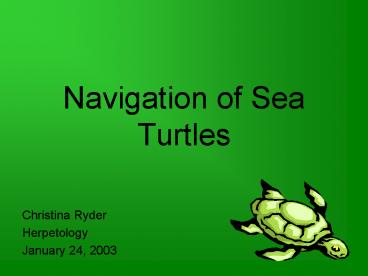Navigation of Sea Turtles - PowerPoint PPT Presentation
1 / 16
Title:
Navigation of Sea Turtles
Description:
Special adaptations for life at the sea -large shells for protection ... A turtle usually spends about 5 to 7 years circling the Sargasso Sea. ... – PowerPoint PPT presentation
Number of Views:389
Avg rating:3.0/5.0
Title: Navigation of Sea Turtles
1
Navigation of Sea Turtles
- Christina Ryder
- Herpetology
- January 24, 2003
2
A Little bit about sea turtles
- from the families Chelonidae Dermochelyidae
- - caretta caretta (loggerhead sea turtle)
- -chelonia mydas (green sea turtle)
- -eretmochelys imbricata (hawksbill sea
turtle) - -dermochelys coriacea (leatherback sea
turtle) - -lepidochelys kempi (Kemps ridley sea turtle)
3
- Loggerhead sea turtle
- Green sea turtle?
Hawksbill sea turtle ?
?Leatherback sea turtle Kemps ridley sea turtle?
4
and a little more
- Special adaptations for life at the sea
- -large shells for protection
- -tough keratinous beak to bite
- -modification of limbs to flippers for
swimming
5
The great journey
6
from the beginning
- Hatchlings must leave the nest to safely get to
the sea to find food, shelter, and warm water
7
So how do they do it?
- They must rely on the reflection of the moon and
stars on the ocean, the downward slope of the
beach, and the lack of vegetation to get them to
the sea
8
Then, Its off to the Gulf Stream
- Once in the water, the baby turtles must find the
current of the North Atlantic gyre. For as long
as possible, the turtle swims against the waves,
away from the coast. They also use the direction
of the waves to set their compasses for future
reference.
9
Staying in the gyre
- For the rest of its life, except time to lay
eggs, the turtle will remain in the gyre, relying
on the waters to provide food and warmth. - A turtle usually spends about 5 to 7 years
circling the Sargasso Sea.
- Getting off-course is deadly. The turtle must
turn south or else the current will carry him or
her to the frigid waters of England.
10
So, how do they do it?
- By using their internal compass and magnetic
inclinations to sense the angles created by the
magnetic field. - By sensing the slight change of angle, the turtle
is able to make the correct turns to follow the
current to stay alive. - 57? ? Florida beach
- 60?? Gulf of Portugal
11
So, how does it work?
- The earth has a magnetic field best described as
lines of magnetic force that flow around the
planet from the magnetic South Pole to the North
Pole.
- Turtles brains contain the magnetic mineral
magnetite used for detection and orientation.
12
And then they return
- When the female is mature and is ready to lay
eggs, she returns to the very beach at which she
was hatched. - She digs a hole, lays her eggs, and then returns
to the ocean.
13
How does she get there?
- By swimming , of course!
But how does she know where to go?
- In addition to a sense of direction and guidance
by their magnetic inclinations, sea turtles have
map-sense. (They remember the relativeness of
one location to another.)
14
and the whole journey starts over again
15
Conclusion
- the loggerhead migration picture mow looks like
this Hatchlings emerge from their beachfront
nests at night and head toward the bright light
coming off the ocean, setting their magnetic
compasses. Once in the water, they swim directly
into the waves. Swimming into the waves keeps
the youngsters heading away from the coast. When
they hit the Gulf Stream, they ride the current,
relying on their magnetic inclination compasses
to tell them when to turn and head south for the
Sargasso Sea. Then, in late adolescence, they
find the magnetic inclination angle of the
Florida beaches and ride it home.
-according to Kenneth Lohmann
16
References
- www.cccturtle.org/behav.htm
- www.google.com
- Reptiles and Amphibians. Roger Conant/ Joseph
T. Collins ed. Houghton Mifflin Company, 1998. - Sea Turtles Master Migration with Magnetic
Memories. Science. April 29, 1994 v264 n5159
p661(2) - www.unc.edu/depts/oceanweb/turtles/































